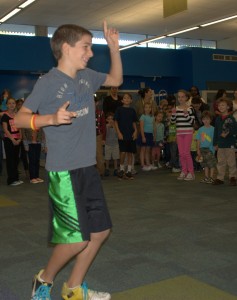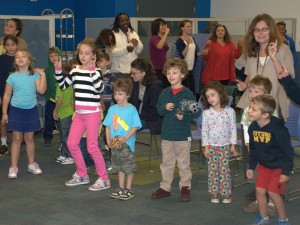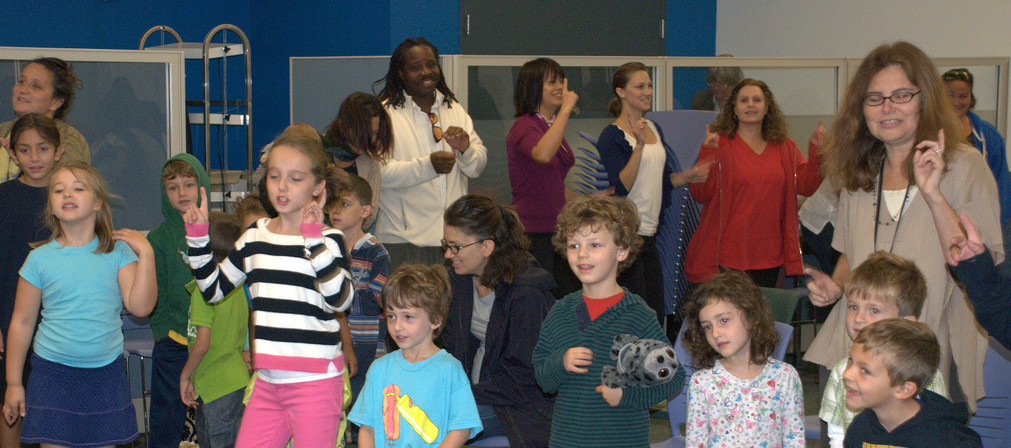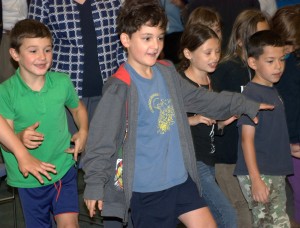
Most Wednesday mornings the lower school assembles in the Chapman Room and parents are welcome. It’s usually a showcase for the work of the classroom and often includes the opportunity to sing.
First the Hokey-Pokey
On a recent Wednesday a seventh grader led children, parents and teachers in singing and dancing the hokey–pokey. It was music, movement and a great moment of togetherness – audience participation at its best and a fun way to start the day.
Last June, 2,351 dancers did the same thing on the Walkway Across the Hudson earning a place in the Guinness Book of Records.
And of course, while we were all singing and dancing I don’t think any one of us was thinking about stirring up sectarian soccer strife, promoting substance abuse or mocking a major world religion.
Say what…?
In 2008, a few Glasgow Rangers football fans were accused of planning to sing the hokey-cokey (as it is better known in the UK) at a match with Glasgow Celtic – a club with Catholic associations. The teams have a long-standing and bitter rivalry that has often turned ugly. The story erupted in the British press with politicians and clergy weighing in from all sides. What seemed to most a harmless dance routine had been unearthed as a plot to stir Scottish sectarian soccer singing intended to mock and insult.
Why?
How could an innocuous party routine that I always associate with footage of plucky Brits keeping cheerful and carrying-on during the Second World War have the power to generate such a heated political debate?
The story from history and etymology is murky.
The name derives from hocus-pocus meaning magical nonsense. And hocus-pocus appears to have entered the language by way of protestant mockery of priests presiding at mass who – with their back to the congregation – intone hoc est enim corpus meum “this is my body” in the traditional ritual of transubstantiation.
There’s also some evidence of a British – centuries old, now long forgotten -dance parody of that “hocus-pocus”.
The modern version has ambiguous and often disputed origins but seems to date to Second World War London. According to the story told by his son, songwriter Jimmy Kennedy heard Canadian soldiers singing in a nightclub. Their version had to do “with drugs taken by the miners in Canada to cheer themselves up in the harsh environment where they were prospecting”. Kennedy liked the tune and went back to his hotel to write the version we are more familiar with today as a way to raise morale in wartime. He called it the Cokey-Cokey.
With the exception of a few Rangers fans who thought the song had potential for subverting the ban on stirring sectarian hatred, the associations with the mockery of Catholics seem tenuous and lost in the mists of history. So, for now, we will still be putting our right foot in – safe in the knowledge we are not engaging in a routine designed to insult.
But here’s another curriculum landmine that is not quite so easily dismissed.
Why we decided to stop teaching Jump Jim Joe
There’s a staple of school music and movement curricula called Jump Jim Joe.
You gotta jump-jump-jump Jim Joe.
Shake your head and nod your head and tap your toe.
Round and round and round you go.
Then you find another partner and you jump Jim Joe.
The tune is toe-tapping catchy, the words are simple, and the steps easy to learn. And at PDS apparently it’s been a part of the curriculum for years.
So what’s the problem?
Turns out that Jump Jim Joe (rhymes with…) is a direct descendant of an entertainment routine created in about 1830 and made popular on two continents by Thomas D. Rice.
Rice was a white, minstrel show performer who blackened his face and became famous playing a series of outlandish characters based on white stereotypes of black people. One of them – Jim Crow – danced a ridiculous jig while singing Jump Jim Crow.
Wheel about and turn about and jump just so,
Every time we wheel about we jump Jim Crow.
He often extended and changed the words of the song to comment on current affairs.
Rice’s fictional character was based on a lie – the convenient (for defenders of slavery) myth of the contented, happy-go-lucky slave. His routine became so popular and well known it established the name as the adjective to describe the segregationist laws and practices that scarred the century following the Civil War: Jim Crow
Scholars delving into the cloudy history of Jim Crow find a complex story. Rice made a fortune creating foolish stereotypes of black Americans but he also created blackface characters that resisted oppression and subverted conventions. He wrote a romantic version of Othello, for example, where the hero and Desdemona have a child and live happily ever after.
To make matters more complicated, historians think that Rice appropriated the Jim Crow persona from traditional black folklore and some would like to reclaim the dance as a part of honoring that legacy. To that end, Jump Jim Joe currently appears on lists of recommended activities to foster diversity, celebrate black history and Martin Luther King.
On the surface Jump Jim Joe is harmless – a catchy tune and a wonderful movement and music activity for young children combining a simple song, easy steps and social interaction.
But, unlike the hokey-pokey, Jump Jim Joe has deep historical resonance and disturbing associations with the segregationist era. Jim Crow was a stock character of mockery and a term of insult that came to stand for a century of racist laws and practices in the south that lasted into the 1960’s. It is, moreover, embedded in the entertainment tradition of minstrelsy that is based on cultural appropriation, distortion, mockery and derision.
For those reasons we will not be including Jump Jim Joe in our music and movement classroom any time soon. I am grateful for the parent who brought this complex history to my attention. That conversation helps us be more thoughtful about our practice. And it has led me to begin a journey into a fascinating vein of American history. It speaks to me of the importance of being aware – as best we can – of origins and meanings of our words and traditions – so that we can always be sensitive to their implications and teach them in an appropriate context.
The choices we make matter. And it is the impact – not our intentions – that should guide us. If the effect is hurtful – or has the potential to be so – then we have to pay attention and reconsider our choices.




I had no idea! I think I’ll have to go and lie down with a wet cloth on my head to recover. No idea at all. Thank you for this totally interesting post.
Gwen.
Thanks for this blog post and for the link shared by Plain Marie. So much to learn about the history of certain songs…
For more information about the history of “Jump Jim Joe,” this extensive web archive collects a wealth of information about this and other songs from the pervasive history of minstrelsy. Very informative and eye-opening.
https://web.archive.org/web/20160718104838/http://exhibits.lib.usf.edu/exhibits/show/minstrelsy/jimcrow-to-jolson/jump-jim-crow/
Great resource. Thank you.
This was written 8 years ago but it’s so timely right now.
All schools need to be going through their curriculum materials with a fine-toothed comb and a magnifying glass. Racist content and attitudes lurk in the most “innocent” of places – and this is a great example.
“It speaks to me of the importance of being aware – as best we can – of origins and meanings of our words and traditions – so that we can always be sensitive to their implications and teach them in an appropriate context. The choices we make matter. And it is the impact – not our intentions – that should guide us. If the effect is hurtful – or has the potential to be so – then we have to pay attention and reconsider our choices.”
Thanks Jennifer. Agreed 100%.
We sung this song in elementary school and I dont even live in a racist area. I am currently in summer school and we are learning about Jim crow laws. My teacher said something about, Jump Jim Crow. When he said this I finally connected it to Jump Jim Joe, The song I learned so long ago.
Racism is everywhere hiding in plain sight. And sometimes not even hiding. It lurks in our language and it lurks in the curriculum.
Thanks for adding your comment.
Anti Catholicism- the last acceptable prejudice. This article proves that. H.P. mocks the very essence of Catholicism- and to turn yourself around is another jab at the ad oriented posture that the priest assumes in persona Christi.
Thanks. I had NO idea that this song came from such racist origins. And I bet most people have no idea either. Thing is: Now they know – will it make any difference to their choice? Would love to hear from people who think it doesn’t matter!
The information is on the post and in the links. Basically – if there is any doubt – don’t do it! Why risk insulting people. ignorance is no longer an excuse.
Hi Amanda:
I’m assuming you are referring to Jump Jim Joe and not the Hokey-Pokey.
The “hard” evidence is the links. If you follow the threads you can discover the troubling yet fascinating history of the song.
I think reasonable people can disagree on whether it should be included in a curriculum. However, the origins of the dance and song certainly give me pause. I spent quite some time digging as best I could online and found sufficient background for my conclusions. And in the end I did not need the so-called proof. While many or most may be oblivious of the song’s history and associations, others are not and they may be offended. That’s enough for me and I was pleased it had been brought to my attention. Knowledge is good!
Another alternative would be to include the song as part of a full and comprehensive study of the history of race, racial stereotypes and cultural appropriation. And that’s not for the early childhood years!
The history of all these traditional songs is always so interesting.
I am having trouble finding evidence of this other than what a parent said. This deeply disturbs me and I’d like to find hard evidence that supports this so I can make changes to my curriculum as needed….